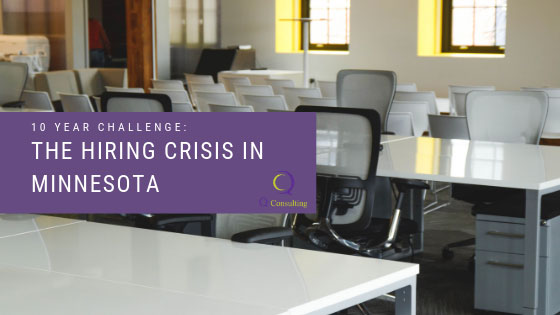With unemployment rates at a 50-year low, it comes as no surprise that the job market and hiring landscape in Minnesota look vastly different than 10 years ago. According to the Minnesota Department of Employment and Economic Development, in Q2 of 2009 there were 31,000 job vacancies and 232,000 unemployed people. Ten years later in Q2 of 2018 there were 142,000 job vacancies and 88,500 unemployed people. Wow, what a dramatic switch! In 2009, we remember a time where candidates were actively looking for new roles, while few companies were hiring. Today, the market is the opposite; companies are desperate to hire qualified candidates while very few candidates are actively looking in the market.
In talking with our clients it is apparent that the low unemployment rate is having a significant impact on companies. There are far more open positions in the Twin Cities than there are qualified candidates to fill them. It’s extremely rare to open your LinkedIn news feed without seeing a Recruiter posting for an open position in tech areas like Development, User Experience, Business Analysis, Data and more. The struggle to find candidates is real. Star Tribune posted an article last month that specifically talked about the IT industry, “The Twin Cities has about 136,000 tech workers, Greater MSP said, and openings for about 50,000 jobs”. 50,000 job openings? That is an astounding number! With statistics like this it is clear we are amid a hiring crisis! With the struggle to hire qualified candidates teams are stretched thin, hiring managers are panicking, and projects are going into the red. Many of our clients have come to us to ask, “So, what do we do?”
Although we do not have the answers to avoid a labor driven recession, we do have a few recommendations that companies can implement today to help during the hiring crisis.
First, hire consultants! Need an expert to come in and hit the ground running? That’s what Consultants are ready to do. Instead of leaving FTE seats unfilled, bring in a SME who can contribute immediately. At the very least with a Consultant the work is getting done and who knows, that very consultant could convert to an FTE down the road.
Secondly (and we cannot stress this one enough), streamline the interviewing and hiring process. With such a high demand for qualified candidates, active candidates are receiving multiple offers at the same time. If you’re losing out on hiring top candidates, look at your interviewing process and ask if you can make it more efficient. Clients who make hiring decisions quickly are landing the highly sought-after talent first (and often at the best rates).
Finally, try not to get caught up in all the “must have requirements” on the job description; hire for aptitude. We recently worked on an opportunity for a top client. They had a need for candidate with a niche skill set and 5+ years of experience. We coached them through the process of considering a Consultant with some of the must haves AND a desire to learn and grow. They took the chance and 6 months later, the candidate we placed has become a “go-to” person on their team. With such a shortage of qualified candidates, we must determine what the true must haves are. What’s better? Hiring someone who has knowledge and is a quick study or leaving seats unfilled and work undone?
There is no doubt that there is a hiring crisis here in Minnesota. There may be no way to avoid all the consequences that come with having more job openings than people. But with consultants and an efficient hiring process companies can keep projects from going uncompleted and allow their business to stay competitive. We can’t prevent what is to come, but we can be more effective in this market! Where will the market be in another 10 years?
